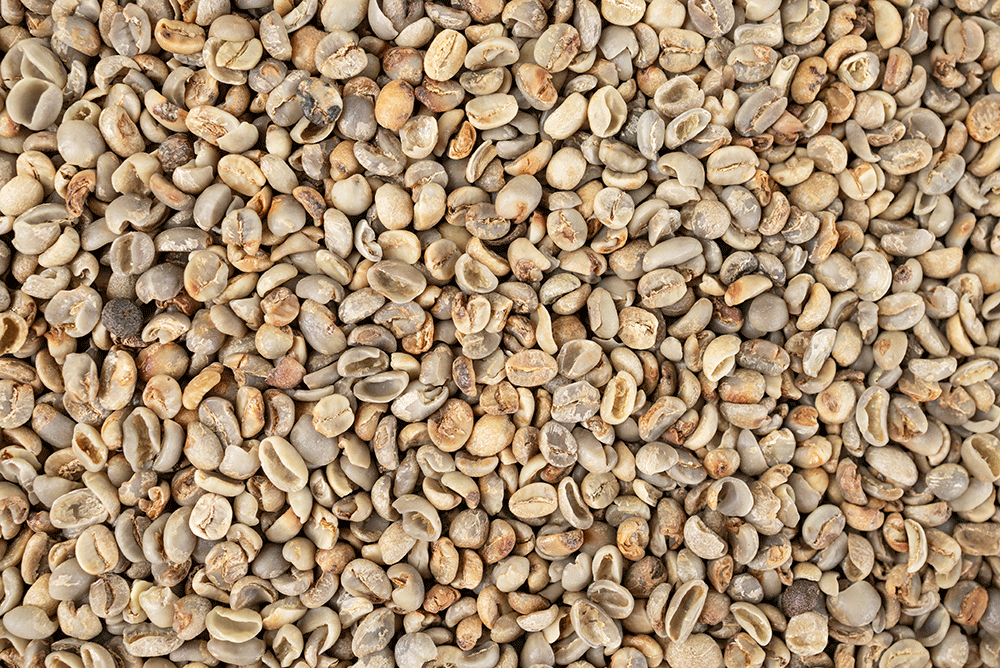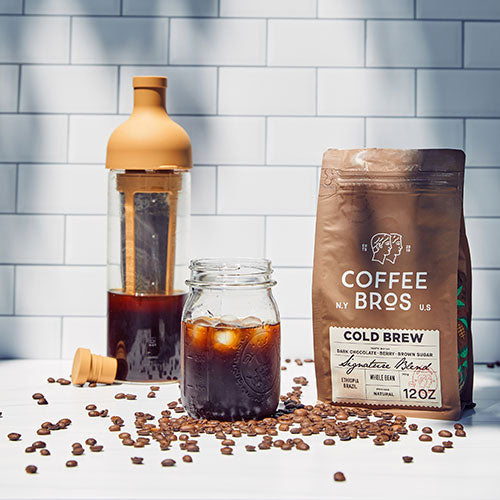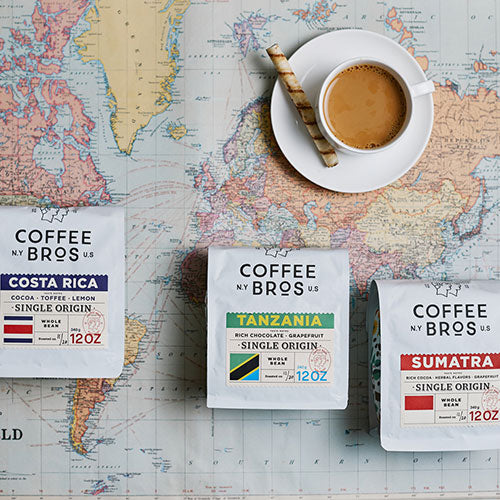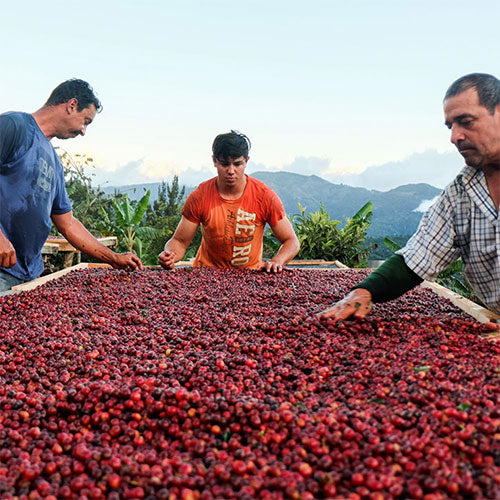Written: October 3rd, 2025
Introduction
If you’ve spent time browsing coffee online, you’ve likely seen alarming claims: “Over 90% of coffee is moldy” or “your coffee is full of dangerous mycotoxins.” Some brands charge two, three, or even five times more for beans labeled “mold-free” or “mycotoxin-free.”
At Coffee Bros., we take quality seriously. So, we decided to test six of the most popular coffees sold in the U.S. (we even tested our own coffees) — including two of the biggest names marketing “mold-free” coffee, as well as Amazon’s cheapest coffee and brands like Starbucks, Peet’s, and Lavazza.
The results? Stick around to find out – it might surprise you!
What Are Mycotoxins in Coffee?
Mycotoxins are toxic compounds produced by certain fungi, like Aspergillus and Penicillium. The two most often discussed in coffee are:
- Aflatoxin B1 is known as a carcinogen.
- Ochratoxin A (OTA) is linked to kidney stress and is suspected to be carcinogenic.
While this sounds concerning, it’s essential to understand:
- Regulators set strict safety limits (the EU sets OTA limits at 3–5 µg/kg for roasted coffee).
- Levels in coffee are consistently well below these limits.
- Your liver naturally breaks down low-level mycotoxins, preventing buildup (as explained in the Healthline review) [^1]
Are There Yeast and Mold in Coffee?
Like all agricultural products, coffee can be exposed to molds during harvest or storage if mishandled. But specialty-grade coffee — which comprises most beans for U.S. roasters — already eliminates many of these risks:
- The Specialty Coffee Association (SCA) grading system automatically classifies mold as a defect, resulting in the rejection of moldy coffee beans.
- Moisture-controlled drying and hermetic storage reduce contamination risk.
- Roasting kills molds and reduces mycotoxins — studies indicate roasting reduces OTA levels by 69–96% [^1].
In short, if you’re buying specialty-grade coffee, mold is extremely unlikely to be a real issue.
Why Coffee Companies Push the Mycotoxin & Mold Agenda
Over the past decade, a handful of coffee brands have positioned themselves as the loudest voices in the “mold-free” and “mycotoxin-free” movement. Their messaging has spread widely, leading many consumers to believe that most coffee is contaminated unless proven otherwise.
Two of the most prominent names driving this narrative are Lifeboost Coffee and Danger Coffee, both of which heavily market their beans as lab-tested and safe from toxins. Their claims often rely on exaggerated statistics, emotional language, and promises of health benefits that exceed what science supports. This language rivals that of the supplement industry, which is riddled with false claims and navigates a fine line with what the FDA allows.
There are other brands, such as Purity Coffee and Clean Coffee, that also lean on “mold-free” or “toxin-free” marketing to justify premium pricing. While Purity was not included in our testing, their messaging follows a similar playbook: raising fears about contamination, then presenting their product as the clean alternative.
Lifeboost Claim vs. Reality
“99.1% of coffee beans are covered in mold.” [Lifeboost blog post]
Reality (Science)
Independent reviews and studies (e.g., Healthline) indicate that roasting reduces OTA levels dramatically [^1], and regulatory data suggest that coffee contributes only a small fraction of the permissible OTA intake. Also, mold defects would prevent high-scoring, specialty-grade coffees from entering the market.
Danger Coffee Claim vs. Reality
“Your coffee is probably moldy… high roasting and brewing temperatures don’t destroy the dangerous mycotoxins” [Danger Coffee blog]
Reality (Science)
The Healthline review cites multiple studies confirming that roasting significantly reduces mycotoxins [^1]. And as our own tests show, even coffees marketed as “mold-free” tested clean.
The Truth About Mycotoxins and Mold in Coffee
The Healthline article offers a clear conclusion: “Paying extra for mycotoxin-free coffee beans is most likely a waste of money.” [^1]
Meanwhile, the PubMed article (PMC) confirms that while fungi can generate mycotoxins in controlled laboratory settings, in real-world coffee production, careful processing and roasting minimize or eliminate them (see, e.g., “Determination of potentially mycotoxigenic fungi in coffee”) [^4].
So, the bottom line is that tiny traces may occasionally exist, but they’re far below harmful thresholds — and specialized processes further reduce them.
- But in real-world coffee production, careful processing + roasting reduce or eliminate them.
- Even lower-quality coffees test below international safety limits.
How Roasters Prevent Mold in Coffee
Sourcing of high-grade specialty coffee
First and foremost, sourcing specialty coffee (80pts and above – but really 84–86pts and above) will drastically limit, if not eliminate, the presence of mold.
Specialty coffee is built around a grading system that reduces a coffee's score based on cup quality (taste) as well as the absence of defects. Defects range from unripe or broken/chipped coffee beans to those with a presence of fungus or mold.
The higher the score of a coffee, the lower the likelihood of mold presence at the time of scoring.
Transporting the coffee in hermetically sealed bags
Raw coffee does contain roughly < 15% on average, and raw coffees with a higher moisture content have the potential to develop mold even post-grading. If you think about the opposite end of the scale, where fruit has 75% - 92%+ moisture present and is more likely to spoil or mold quickly.
That said, while coffee has much less moisture, it is still present, and specialty coffee roasters want to eliminate any potential mold or mycotoxins in coffee. Specialty coffee roasters take extra precautions by wrapping their coffee in hermetically sealed packaging inside the unfortunately porous burlap sack. Since burlap is porous (and much non-specialty coffee is just shipped in only burlap), specialty coffee roasters take the extra step to seal and protect the coffee during its journey from farm to roastery to protect it from any unforeseen issues like odors, moisture buildup, and then mold and mycotoxins.
At Coffee Bros., we ship all our coffee in hermetically sealed bags, not only for the improved quality but also for the positive benefits producers receive from food loss prevention to increased value for their goods.
Buying and roasting coffee in-season
Although this may seem obvious, not every coffee roastery considers seasonality when purchasing and selling coffee or rotating coffees in blends to maintain freshness. The sooner a coffee is consumed (roasted), the less chance mold will ever be present. Find coffee roasters who source quality, specialty coffee, tout seasonality, and ship their coffees from farm to roastery quickly and in hermetically sealed bags.
The Results: Lab Testing 6 Popular Coffees
We tested six popular coffees — from the cheapest bag on Amazon to the priciest “mold-free” coffee beans, which are marketed as such. Every sample was tested by Cambium Analytica, an ISO-accredited lab, for aflatoxins, ochratoxin A, and yeast/mold counts.
All results came back Not Detected (ND).
| Brand / Coffee | Price / Oz | Price | Aflatoxins | Ochratoxin | Yeast & Mold | Result |
| Amazon Fresh / Medium Roast | $0.57 | $6.78 | ND | ND | ND | PASS |
| Lavazza / Crema e Aroma | $0.64 | $22.53 | ND | ND | ND | PASS |
| Peet's / Major Dickason's | $0.75 | $13.44 | ND | ND | ND | PASS |
| Starbucks / Veranda | $0.75 | $20.97 | ND | ND | ND | PASS |
| Coffee Bros. / Espresso | $1.58 | $18.99 | ND | ND | ND | PASS |
| Lifeboost / Grata | $2.42 | $28.99 | ND | ND | ND | PASS |
| Danger / Medium Roast | $3.21 | $34.95 | ND | ND | ND | PASS |
Key Takeaway: Consumers are being asked to pay up to 5–6× more per ounce for coffee marketed as “mold-free,” even though independent testing shows all coffees — from $0.57/oz Amazon Fresh to $3.21/oz Danger Coffee — are equally clean.
A Note from Coffee Bros.
At Coffee Bros., we also test our coffees for mold and mycotoxins. To be transparent, we don’t do this because specialty coffee is unsafe — in fact, the specialty supply chain is designed to prevent these defects through grading and selection.
But fear-based marketing has made consumers wary, so we felt compelled to confirm what we already knew: our coffees are clean.
The difference is, we don’t use this as a gimmick or an excuse to charge inflated prices. Instead, we price our coffees based on what truly matters:
- Fair, sustainable relationships with producers.
- High-quality (86+ point) coffees that deliver exceptional flavor.
- Transparency and care from farm to roast.
Specialty coffee should be celebrated for its quality and the people behind it — not fear of contaminants that aren’t there.
Conclusion: Don't Fall for the Gimmick
The myth that 90% of coffee is moldy or toxic is a marketing tool, not a scientific reality. Our testing and global research show the same conclusion: coffee is safe, clean, and delicious.
So, the next time you see “mold-free” or “mycotoxin-free” badges used to justify premium pricing, know the truth: you’re better off investing in high-quality specialty coffee that supports farmers and values flavor — not paying extra for fear.
Sources
-
Healthline – The Mycotoxins in Coffee Myth
https://www.healthline.com/nutrition/the-mycotoxins-in-coffee-myth -
Lifeboost Coffee – The Truth About Mold on Most Coffee Beans
https://lifeboostcoffee.com/blogs/lifeboost/the-truth-about-mold-on-most-coffee-beans?_pos=1&_sid=5776aae26&_ss=r -
Danger Coffee – Mold, Mycotoxins & Lab Testing
https://dangercoffee.com/blogs/news/mold-mycotoxins-lab-testing -
PubMed Central – Determination of Potentially Mycotoxigenic Fungi in Coffee (Coffea arabica L.)
https://pmc.ncbi.nlm.nih.gov/articles/PMC6049681/ - Winning The War Against Stale, Moldy Flavored Specialty Coffee https://news.grainpro.com/winning-the-war-against-stale-moldy-flavored-specialty-coffee




